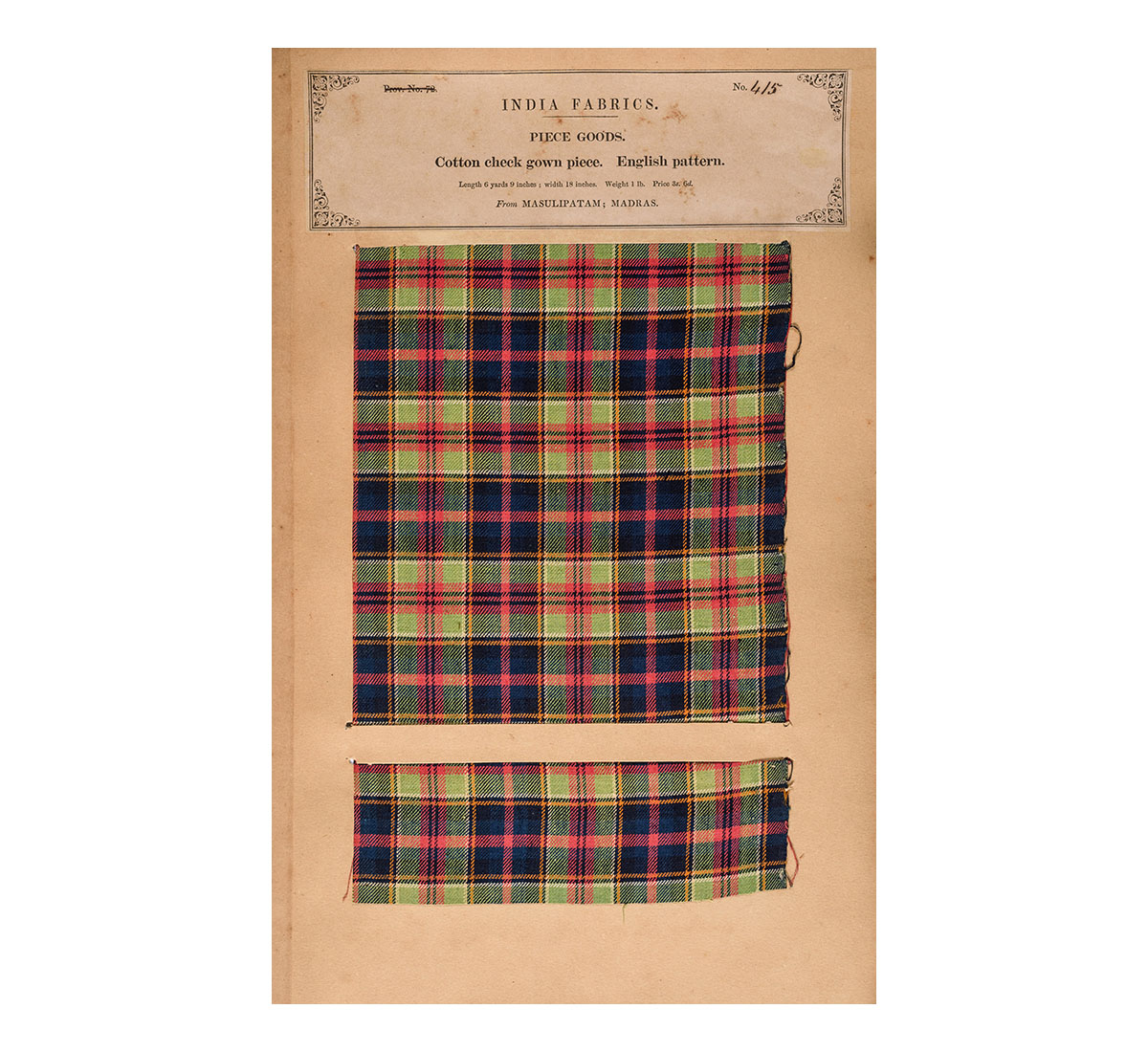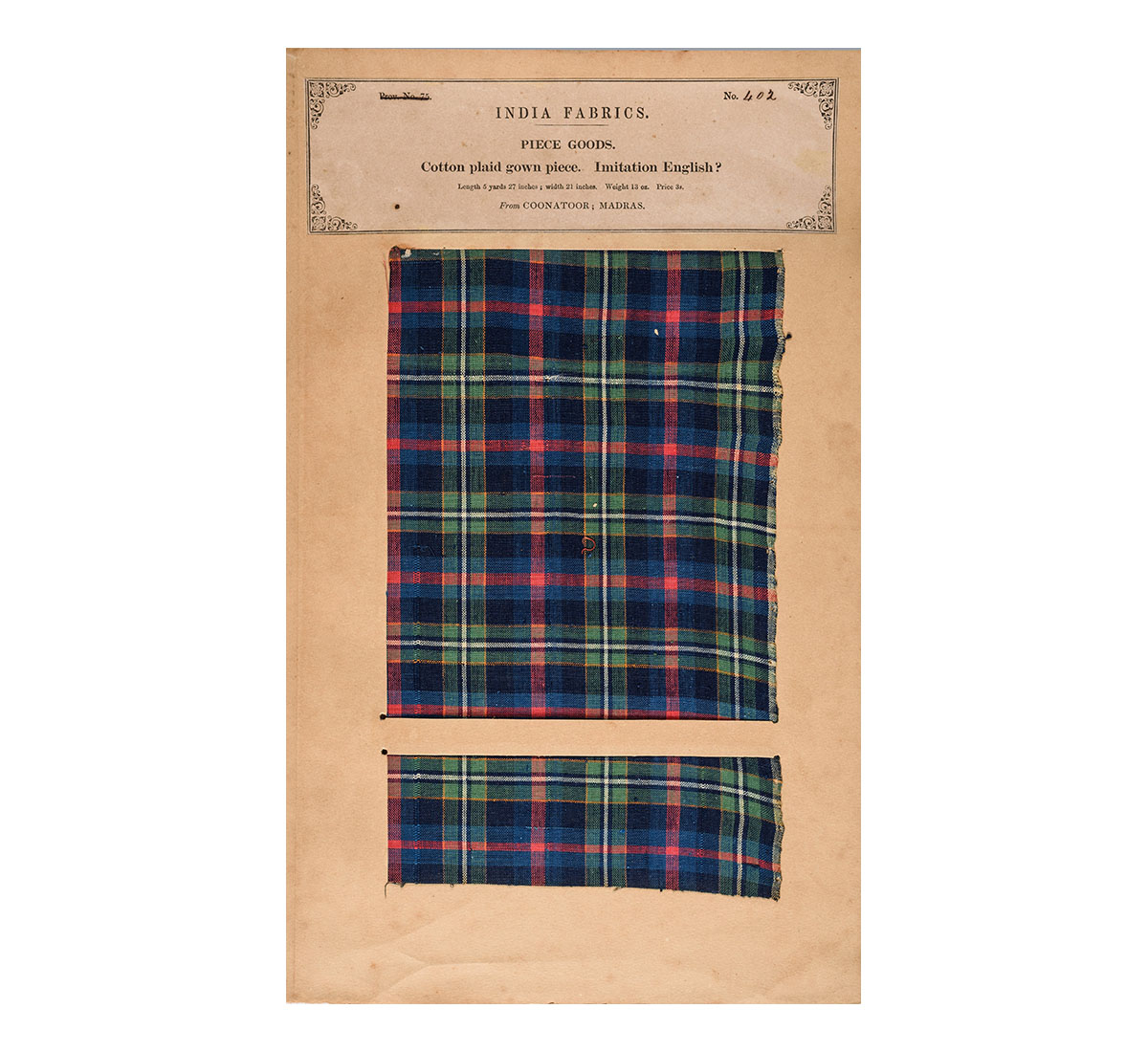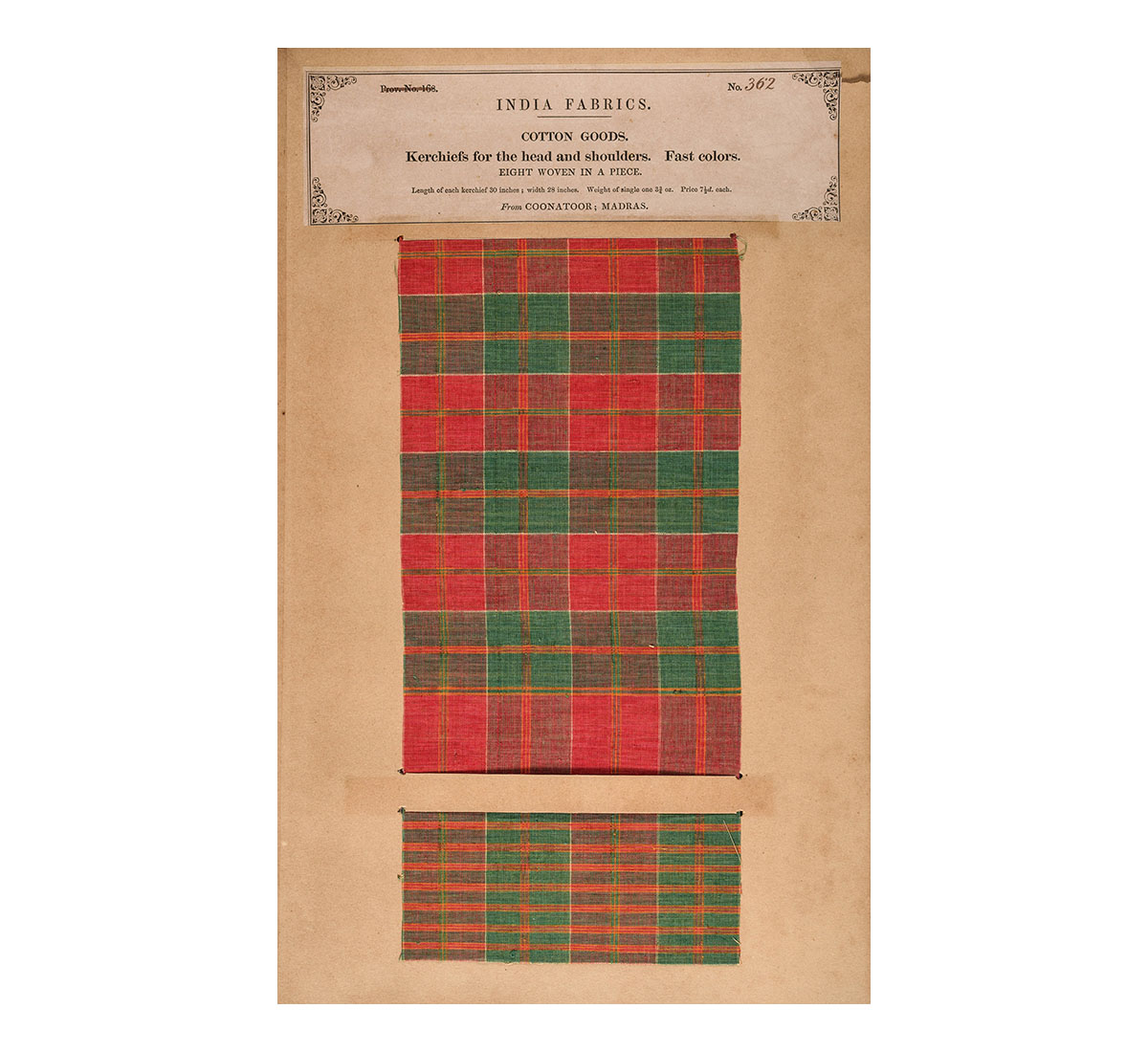ARTICLE
Madras Checks
A colourful plaid cotton fabric from southern India, Madras checks — also known simply as Madras — derives its name from the colonial export centre of Madras (now Chennai, Tamil Nadu) from where it was shipped internationally from the sixteenth to the late twentieth century. Traditionally handwoven on pit looms with natural-dyed yarn, it was produced in various places along the southeastern coast of India, including Madras. Used for scarves, wraps and tailored clothing, Madras checks found diverse markets across Southeast Asia, Africa, Europe and the Americas, sold under trade names such as Real Madras Handkerchief (RMHK) and Bleeding Madras. It became embedded in indigenous cultural traditions in Africa, everyday clothing in Southeast Asia and the Caribbeans, as well as cosmopolitan fashion in the US. From its origins as a utilitarian fabric, the history of Madras checks is closely linked with that of transcontinental colonial trading, indentured labour, regional and cultural identity, and contemporary fashion.
The principal weaving centres for Madras checks have included small clusters as well as extensive setups in the towns of Kurinjipadi, Chirala, Nagapattinam, Ami, Gummidipundi, Saidapet, Perala and Sullurpet, in the present-day states of Tamil Nadu and Andhra Pradesh. The traditional production of Madras checks involves hand-dyeing the short-staple cotton yarn in vegetable-derived red, blue and yellow dyes, which combine during weaving to produce various shades including green and brown. The yarn is also sized using rice paste and coconut or sesame oil to make it abrasion-resistant, and treated in hot water. The fabric is commonly woven while the yarn is still wet with dye; the weft, often undyed, picks up the colours of the warp yarn, and a range of colours emerge from limited dyes. The fibres expand to their full extent only after the fabric dries, making the finished weave extremely compact. The fabric is often heavily starched. The materials used during the process — including indigo, turmeric, oil, and the rice gruel — as well as specific properties of the local water, give the final fabric a distinctive tactile and visual characteristics and smell. These also vary slightly by region and technique. As a plain-weave fabric, Madras checks appears the same on both its faces.
The distinctive weave pattern is often thought to have been inspired by Scottish tartan plaids — from the Scottish troops posted in South India in the 1800s as well as King George IV’s fascination with the Scottish fabric. However, the textile repertoire of South India is also known to have included kattam (‘checks’ in Tamil) and kodu (‘stripes’) long before that. Early versions of the Madras check were among the most prominent cotton fabrics historically produced in the region, and are thought to have been used locally for lungis and unstitched garments since as early as the thirteenth century. Similar yarn-dyed fabrics from South India — sometimes also included under the general category of Madras — included the more finely patterned telia rumal and the blue-and-white Guinea cloth, which became popular trade commodities to West Asia and West Africa respectively. With the travel of Tamil sailors, merchants and workers over the following centuries, checked cotton lungis became popular attire, especially among Muslim men, in many South and Southeast Asian countries, and continue to be worn among the working class across these regions.
With Portuguese trade in the sixteenth century, the fabric reached West Africa, where it became especially popular among the Kalabari and Igbo peoples in the region of present-day Nigeria. Used for head scarves and wraps, it also came to occupy talismanic and ritual value among these communities, featuring prominently in important ceremonies, such as those surrounding births and deaths. It came to be known among the Kalabari as ‘Injiri’ — a colloquialism for ‘real India’ — and among the Igbo as ‘George’ cloth — after Fort St George, the British trade centre around which the city of Madras developed.
Under British colonial rule from the seventeenth century onwards, Madras checks saw accelerated production — especially after the introduction of the flying shuttle in the mid-eighteenth century, which enabled wider fabrics to be woven efficiently on a hand loom. While previously produced and traded in roughly 1-metre-wide lengths, at the peak of its popularity in the twentieth century the cloth was made between 2 and 3 metres wide and about 8 metres long. Each such length could be cut into three ‘handkerchiefs’ — a trade term that covered a variety of square textiles locally called rumal (‘face-wiping cloth’ in Persian and Hindi). The fabric was shipped from India to Britain as bales of fabric to minimise taxation, and auctioned in Manchester and London — chiefly by two companies — to buyers who traded it in overseas markets. In 1907, one of them, A. Brunnschweiler & Co., set up an operations centre in Madras to trade directly from there; with this, Indian trading companies too started to trade in these fabrics. The more coarse fabric was used for lungis and turbans among the local population, and later also by Indian migrant workers in Sri Lanka, Burma (officially Myanmar) and Southeast Asia, while the relatively finer and softer fabric was exported.
Meanwhile, other countries such as Japan, Germany and Switzerland were using early power looms to mass-produce imitation Madras. This did not compete successfully with the handwoven fabric, whose strength, density, feel and even smell customers around the world were used to. British traders added the word ‘real’ to their Madras handkerchiefs to distinguish them from their machine-made counterparts, and Real Madras Handkerchief became the standard term for the British-traded fabric being sent to West Africa.
The growing popularity of Madras checks in Europe during this period led to a ban on the fabric’s wholesale in countries such as England and France, in order to protect local textiles from competition. These traders sought overseas markets, and Madras checks became a high-value commodity along their slave-trading routes between West Africa, the Caribbean islands and the US — sometimes also used as currency in the purchase of enslaved persons. African workers, who had integrated the fabric into their customary dress, retained it through enslavement, and, after they were freed, adapted it into clothing that synthesised African and European influences. Each region in the Caribbeans favoured a unique pattern and combination of colours, so that different plaid designs became markers of regional identity. Given its history as well as its bright colours, Madras checks continues to be used as a symbol of resilience and defiance against racial oppression today. It is used as headgear and wraps, particularly by Black women in these countries. The fabric also features in the national dress of several Caribbean countries — in Antigua and Barbuda, for example, Madras checks in red, gold and green is officially used in the headwear for women and waistcoats for men.
By the end of the nineteenth century, Madras checks was being used to make garments such as shirts in mainstream fashion in the US. However, its demand reached fever pitch in the 1950s and 1960s as it became a fashion statement. Wealthy students of elite American universities popularised clothes made with the fabric they acquired while on holiday or sporting tours to the Caribbean colonies. In the late 1950s the Indian entrepreneur CP Krishnan Nair sold a large volume of the fabric to an American textile trader, who failed to warn his buyers about the cloth’s lack of colour-fastness. After an initial uproar about what was seen as poor quality, popular articles and advertising campaigns turned the fabric’s tendency to run colour into a marker of authenticity and status. It was marketed very successfully as ‘Bleeding Madras’ — a fabric that would gradually fade, as well as transform with each wash as the natural dyes merged and changed. Used for a wide range of garments including dresses, shorts and skirts, the fabric became synonymous with Ivy League fashion, even featuring as the official material for Princeton University reunion jackets.
In the early 1990s Madras checks accounted for 10% of India’s handloom exports, and a little under 1% of all textile exports from India. However, the advent of more sophisticated power looms, changing fashion trends, and slowing demand for the cloth in Nigeria and other parts of Africa have significantly impacted traditional Madras checks production since the late 1970s. Modern varieties of the fabric, which are machine-woven and use colourfast dyes, continue to be used in the fashion industry, particularly in the West. Mass-produced lungis in the Madras patterns remain popular as everyday wear in the Indian subcontinent and Southeast Asia. While few weavers today use traditional methods and yarn dyeing to make Madras checks, some design studios are attempting to revive the traditional craft by commissioning it for contemporary styles.
Bibliography
“A Chequered History.” The Hindu, March 15, 2018. Accessed February 13, 2024. https://www.thehindu.com/society/history-and-culture/real-madras-handkerchief-and-the-histroy-arround-it/article23260390.ece.
Anantharam, Chitra Deepa. “Yards of History.” The Hindu, March 21, 2018. Accessed February 13, 2024. https://www.thehindu.com/society/history-and-culture/real-madras-handkerchief-and-the-textiles-of-tamil-nadu/article23311188.ece.
Injiri. “Madras Checks: A Symbol of Egalitarian Fabric.” Techniques. March 16, 2022. Accessed February 14, 2024. https://www.injiri.co.in/techniques/madras-checks/.
Kras, Sara Louise. Antigua and Barbuda. United States: Marshall Cavendish Benchmark, 2008: 79.
Marcel, Kai Toussaint. “Madras Fabric.” The Fashion and Race Database. Objects that Matter. April 6, 2022. Accessed February 13, 2024. https://fashionandrace.org/database/madras-fabric/.
Muzquiz, Albert. “Bleeding Madras: Under the Skin of a Colonial Fabric.” Heddels. May 7, 2018. Accessed February 13, 2024. https://www.heddels.com/2018/05/history-madras-fabric/.
Radhakrishnan, Sabita. “Madras Checks.” Madras Musings, February 1, 2016. Accessed February 13, 2024. http://www.madrasmusings.com/vol-25-no-20/madras-checks/.
Roy, Tirthankar. “Madras Handkerchiefs in the Interwar Period.” The Indian Economic & Social History Review, 39, no 2-3, 2002: 285–300. https://doi.org/10.1177%2F001946460203900208.
Saju, M. T. “Remember the Old Real Madras Handkerchief?” The Times of India, March 12, 2018. Accessed February 13, 2024. https://timesofindia.indiatimes.com/city/chennai/remember-the-old-real-madras-handkerchief/articleshow/63273180.cms.
Sampath, Janani. “How Madras Lost Its Textile Legacy in Checks.” The Federal, August 23, 2019. Accessed February 13, 2024. https://thefederal.com/states/south/tamil-nadu/how-madras-lost-its-textile-legacy-in-checks/.
Snyder, Michael. “Check Republic.” The Caravan, June 1, 2015. Accessed February 13, 2024. https://caravanmagazine.in/reportage/check-republic-madras.









